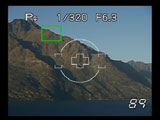Olympus E-410
-
-
Written by Gordon Laing
Olympus E-410 lenses
More Features : Lenses and viewfinder / Screen and menus / Sensor and processing / Anti dust / Anti shake
Olympus E-410 features continued…
Lenses and viewfinder / Screen and menus / Sensor and processing / Anti dust / Anti shake
The Olympus E-410 employs a Four Thirds lens mount and is compatible with the complete range of Four Thirds lenses which at the time of writing totalled 23 from Olympus (including tele-converters and recently-announced models), 11 from Sigma and two from Panasonic / Leica. All these lenses are designed from the ground-up for DSLR use and many offer compelling facilities or features – to find out more about one of our favourite models, check out our Olympus Zuiko Digital 7-14mm review which we’ll be updating soon with E-410 results, samples and a new video tour.
Like other Four Thirds DSLRs, the E-410’s sensor size effectively reduces the lens field of view by two times, so the optionally-bundled Zuiko Digital ED 14-42mm kit lens delivers a 35mm equivalent focal length of 28-84mm. The range of the kit lens in practice is illustrated below.
Olympus E-410 with Zuiko Digital 14-42mm coverage | ||
 |  | |
| 14-42mm at 14mm, f8 (28mm equivalent) | 14-42mm at 42mm, f8 (84mm equivalent) | |
Olympus sells the E-410 as a body alone, or in two different lens kits, one with the ED 14-42mm and the other with both the ED 14-42mm and the ED 40-150mm. These are new kit lenses first introduced with the E-400 and better match the body’s compact dimensions while additionally employing ED glass elements to correct for colour and other optical aberrations; the ED prefix also helps differentiate them from older Zuiko Digital kit lenses, especially as some store bundles may vary.
To put the differences into perspective, the new ED 14-42mm and older 14-45mm kit lenses may share the same focal ratio and virtually identical ranges, but measure 66x61mm and 71x87mm respectively, while weighing 190g and 285g. Clearly the new general purpose kit lens is much smaller and lighter.
The same applies to the new ED 40-150mm which at f4-5.6 may not be as bright as the older 40-150mm f3.5-4.5, but again is much smaller and lighter: 66x72mm versus 77x107mm and 220g compared to 425g. Clearly if you’re going for the twin lens kit, that’s quite a saving in size and weight, and as a neat addition, the new models also focus closer than the old ones. See our Olympus E-400 results pages to compare the new ED 14-42mm with the older 14-45mm kit lens.
It’s also important to note both new kit lenses feature internal focusing so their end sections don’t rotate. This comes as much relief for users of polarising filters for whom kit lenses like Canon’s EF-S 18-55mm and Nikkor’s DX 18-55mm can be quite infuriating. It’s also nice to see Olympus include lens hoods with both these kit lenses.
The big downside with the Four Thirds standard though is the lack of image stabilisation options. Olympus believes body-based sensor-shift stabilisation is the way forward and has equipped the forthcoming E-510 with such facilities. Unfortunately though this means there’s no Olympus Zuiko Digital lenses with optical stabilisation. In fact the only stabilised option for the E-410 – and previous Four Thirds DSLRs – is the Leica 14-50mm ‘kit’ lens, which is relatively expensive and often hard to track down outside of a Panasonic L1 bundle.
In March 2007 Panasonic and Leica announced they were developing a new 14-150mm Four Thirds lens with optical stabilisation. Providing the same 28-300mm range as the massively popular Nikkor 18-200mm along with optical stabilisation, this could be a killer all-round lens for the E-410 and existing Olympus DSLR owners, but there’s no pricing or shipping details as yet. So lack of viable anti-shake options today is arguably the worst aspect of owning a E-410, although to be fair it’s a problem also faced by every other Olympus DSLR owner so far.
Olympus E-410
focusing
Like its predecessor, the E-410 employs a fairly basic 3-point auto-focus system. This makes it considerably less sophisticated than the nine and 11-point AF systems of rivals like the Canon EOS 400D / XTi and Nikon D80 respectively. That said, like the 3-point system of the Nikon D40(x), the E-410’s auto-focus is fine for general use and we rarely experienced a time when it didn’t snap onto the desired subject. If you’re into tracking subjects which regularly move around the frame though, the 400D / XTi or D80 could be a better bet.
 |
 |
Finally we should mention like all Four Thirds bodies so far, the manual focusing on the E-410 is motor-assisted. This can feel quite odd if you’re used to traditional mechanical systems and also has quirks like not being adjustable unless the camera’s switched on, not to mention resetting itself to infinity when the power’s switched off.
If manual focusing’s very important to you, we’d advise trying out a Four Thirds body first before buying as you may not get on with the implementation. That said, it’s perfectly possible to manually focus easily and accurately with the E-410, and the addition of Live View gives the chance to enlarge an adjustable area by seven or ten times for precision adjustments – see screen shots above.
Olympus E-410 viewfinder
The Olympus E-410 shares the same optical viewfinder as its predecessor, employing a Penta-mirror system to deliver 95% coverage and 0.92x magnification with a 50mm lens set to infinity.
Like other DSLRs based on the Four Thirds standard, the actual viewfinder view itself can appear smaller than other DSLRs. Due to the squarer 4:3 aspect ratio of their images, the viewfinder frame is slightly narrower than the 3:2 shape of rival models. Since most DSLRs with their cropped sensors already have relatively small apparent frame areas to start with, the Four Thirds ones unfortunately look smaller still.
To be fair, the E-410’s viewfinder, like its predecessor, looks larger and brighter than some earlier models and the viewable frame appears around the same height as that in the Canon EOS 400D – although slightly narrower. It may not appear as large and bright as that of, say, the Nikon D80, but it’s still a big improvement over the relatively small and dim viewfinder experiences of the Olympus E-330 and Panasonic L1.
The ‘spare’ space to the right side of the E-410’s squarish viewfinder frame is used to display shooting information consisting of the aperture, shutter, exposure mode, metering mode, exposure compensation (expressed numerically up to +/-5EV), and a battery icon. You won’t find the ISO displayed in the viewfinder, but it is at least shown on the main screen at all times.
Of course the trump card held by the E-410 over its predecessor is its ability to alternatively compose using its main colour monitor. We’ll fully cover this Live View facility on the next page.




